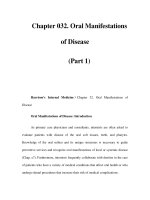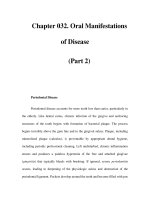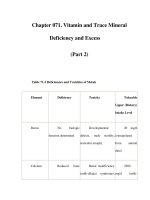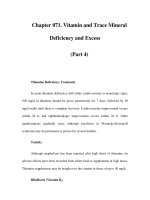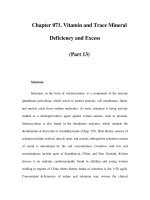Chapter 123. Clostridium difficile–Associated Disease, Including Pseudomembranous Colitis (Part 2) docx
Bạn đang xem bản rút gọn của tài liệu. Xem và tải ngay bản đầy đủ của tài liệu tại đây (77.78 KB, 5 trang )
Chapter 123. Clostridium difficile–Associated Disease,
Including Pseudomembranous Colitis
(Part 2)
Patients colonized with C. difficile were initially thought to be at high risk
for CDAD. However, four prospective studies have shown that colonized patients
actually have a decreased risk of subsequent CDAD. At least three events are
proposed as essential for the development of CDAD (Fig. 123-2). Exposure to
antimicrobial agents is the first event and establishes susceptibility to C. difficile
infection. The second event is exposure to toxigenic C. difficile. Given that the
majority of patients do not develop CDAD after the first two events, a third event
is clearly essential for its occurrence. Candidate third events include exposure to a
C. difficile strain of particular virulence, exposure to antimicrobial agents
especially likely to cause CDAD, and an inadequate host immune response. The
host anamnestic serum IgG antibody response to toxin A of C. difficile is the most
likely third event that determines which patients develop diarrhea and which
patients remain asymptomatic. The majority of humans first develop antibody to
C. difficile toxins when colonized asymptomatically during the first year of life.
Infants are thought not to develop symptomatic CDAD because they lack suitable
mucosal toxin receptors that develop later in life. In adulthood, serum levels of
IgG antibody to toxin A increase more in response to infection in individuals who
become asymptomatic carriers than in those who develop CDAD. For persons who
develop CDAD, increasing levels of antitoxin A during treatment correlate with a
lower risk of recurrence of CDAD.
Figure 123-2
Pathogenesis model for hospital-acquired Clostridium difficile–
associated diarrhea (CDAD). At least three events are integral to C. difficile
pathogenesis. Exposure to antibiotics establishes susceptibility to infection. Once
susceptible, the patient may acquire nontoxigenic (
nonpathogenic) or toxigenic
strains of C. difficile as a second event. Acquisition of toxigenic C. difficile
may
be followed by asymptomatic colonization or CDAD, depending on one or more
additional events, including an inadequate host anamnestic IgG response to
C.
difficile toxin A.
Global Considerations
Rates and severity of CDAD in the United States, Canada, and Europe have
increased markedly since the year 2000. Rates in U.S. hospitals doubled between
2000 and 2003. Hospitals in Montreal, Quebec, have reported rates more than five
times higher than the 2000 baseline, with directly attributable mortality of 6.9%
(increased from 1.5% previously). An epidemic strain, variously known as
toxinotype III, REA type BI, PCR ribotype 027, and pulsed-field type NAP1, is
thought to account for much of the increase in incidence and has been found in the
United States, Canada, and Europe. The epidemic organism is characterized by (1)
an ability to produce 16–23 times as much toxin A and toxin B as control strains in
vitro; (2) the presence of a third toxin (binary toxin CDT); and (3) high-level
resistance to all fluoroquinolones.
Clinical Manifestations
Diarrhea is the most common manifestation caused by C. difficile. Stools
are almost never grossly bloody and range from soft and unformed to watery or
mucoid in consistency, with a characteristic odor. Patients may have as many as
20 bowel movements per day. Clinical and laboratory findings include fever in
28% of cases, abdominal pain in 22%, and leukocytosis in 50%. When adynamic
ileus (which is seen on x-ray in ~20% of cases) results in cessation of stool
passage, the diagnosis of CDAD is frequently overlooked. A clue to the presence
of unsuspected CDAD in these patients is unexplained leukocytosis, with ≥15,000
cells/µL. Such patients are at high risk for complications of C. difficile infection,
particularly toxic megacolon and sepsis.
C. difficile diarrhea recurs after treatment in ~15–30% of cases, and this
figure may be increasing. Recurrences may represent either relapses due to the
same strain or reinfections with a new strain. Recurrence of clinical CDAD is
likely to be a result of continued disruption of the normal fecal flora by the
antibiotic used to treat CDAD.
Diagnosis
The diagnosis of CDAD is based on a combination of clinical criteria: (1)
diarrhea (≥3 unformed stools per 24 h for ≥2 days), with no other recognized
cause; plus (2) toxin A or B detected in the stool, toxin-producing C. difficile
detected by stool culture, or pseudomembranes seen in the colon. PMC is a more
advanced form of CDAD and is visualized at endoscopy in only ~50% of patients
with diarrhea who have a positive stool culture and toxin assay for C. difficile
(Table 123-1). Endoscopy is a rapid diagnostic tool in seriously ill patients with
suspected PMC and an acute abdomen, but a negative result in this examination
does not rule out CDAD.


